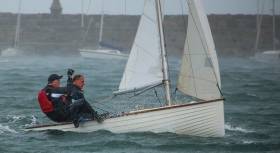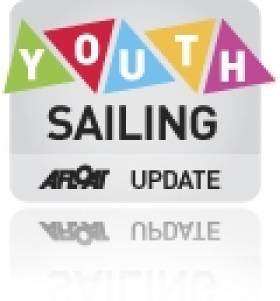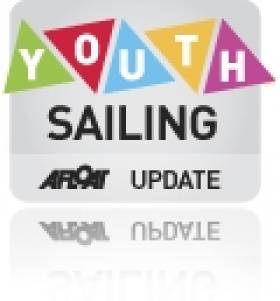Displaying items by tag: Sutton Dinghy Club
Sutton Dinghy Club Welcomes New Commodore At End-Of-Season Event This Sunday
Sutton Dinghy Club’s end-of-season prize-giving this coming Sunday 15 December from 3.30pm is also an opportunity to welcome new Commodore Ian McCormack and Vice-Commodore Ciara O’Tiarnaigh, who were elected at the club’s AGM on Monday night.
With the recent news of some funding for clubhouse upgrades from the Sports Capital Programme, the club with Ian and Ciara at the helm “will be pushing on with some exciting developments”, it says.
Despite poor club racing last season, impacted by the weather as well as restrictions on Dublin Bay, the treasurer reported a stable and well-managed financial position on Monday night.
Allied to increased participation of Sutton’s junior and senior sailors at Class and Open events; a small but significant increase in membership; and great turn-outs for Open and members’ sailing courses, the club says this augurs well for next season — which will feature a visit to the Royal Cork Yacht Club on 25 April as part of its 300th anniversary celebrations.
Sutton Dinghy Club Commodore Stephen Boyle was the first to congratulate the north Dublin club's Billy Bebbington on his win last night in the Fingal Mayor's Community Volunteer Awards.
Bebbington was honoured as the Sports Club Volunteer of the Year, a category in which there were 23 nominations.
Involved as a volunteer in Sutton Dinghy Club for many years, Bebbington is the senior committee boat driver and works tirelessly through the year on a variety of other maintenance activities.
The announcements were made by an independent judging panel.
IDRA 14s 70th Anniversary Dinner at Royal St. George YC This Saturday
The 70th Anniversary of the IDRA 14ft OD dinghy class has been marked in spectacular style throughout the 2016 season writes W M Nixon, with the latest newly-built classic clinker boat (no 166) being launched in June, a well-supported and hard-raced Annual Championship at Lough Derg Yacht Club at Dromineer in August, and a two day celebration afloat and ashore at one of the class’s spiritual homes, Clontarf Yacht & Boat Club, in September. This convivial event was well attended by IDRA 14 sailors past and present - some from very far back – together with a boat and support team from the IDRA 14’s sister class, the Dragonfly OD at Waldringfield Sailing Club in Suffolk. Read Afloat.ie's review here.
However, in the final analysis it’s arguable that the genesis of the class was born within the Royal St George Yacht Club in Dun Laoghaire from the productive minds of Billy and Jimmy Money, together with Douglas Heard.
Douglas Heard was later RStGYC Commodore in addition to being founding President of the Irish Dinghy Racing Association, owner of IDRA 14 Number 1, and winner of the first Helmsman’s Championship in 1947. So all the logic pointed to rounding out the 70th Anniversary Season with a Gala Dinner this Saturday (October 15th) in the Royal St George Yacht Club, and although it’s already well-booked, we’re told there are still some places left which will be of interest to the hundreds of people who have been involved with this remarkable class at some time during the past 70th year.
One of these is Irish Sailing Association President David Lovegrove who raced IDRA No 107 Spray at Sutton Dinghy Club during the 1960s, and he and his wife Kate will be mingling with fellow enthusiasts who will all be talking clinker nine to the dozen on Saturday night. If you’re comfortable with the technology you can make your dinner bookings on line through the RStGYC website, if any queries please ring Ian Sargent at 087 6791069 or Suzanne McGarry at 087 2425331.
Those already booked for the dinner are bringing along IDRA 14 memorabilia including photos going back seventy years, and if you happen to have something in that line yourself you’ll be doubly welcome.
Sutton Dinghy Club Settles With Former Instructor Over Finger Incident
#SuttonDC - A former sailing instructor has settled her case against Sutton Dinghy Club over an incident in which she lost a finger.
As The Irish Times reports, representatives for Hannah Fitzsimons alleged that she had been "required to carry out an unsafe activity and was caused or permitted use a dangerous or unsafe method for towing boats in difficulty".
The claim stemmed from the incident on 11 August 2011 in which her left ring finger was amputated while she was towing a dinghy by hand in waters adjacent to the clubhouse.
An accomplished musician, the Sutton woman said the accident had forced her to give up on plans to be a music teacher and rendered her unable to play the flute or the piano.
The Irish Times has more on the story HERE.
Sutton Dinghy Club Celebrate 75 Years of Dinghies
#suttondinghyclub – With over two hundred in attendance, the black-tie Gala Dinner last Saturday (November 15th) marking Sutton Dinghy Club's 75 years of sailing in Sutton Creek was a Who's Who of many of Ireland's top sailors. The event, staged in the Marine Hotel at Sutton Cross where the Club has had its social home going right back to its earliest days, had been a sell-out for many weeks. And in pride of place in the hotel foyer, beside the Champions & Achievers Honours Board and a photographic history display, was a classic International 12ft dinghy, beautifully restored by former Commodore Aidan Henry, a tangible reminder of the boats raced by the Club in its early years.
In his welcome, Commodore Andy Johnston commented that the large attendance was a celebration of Sutton Dinghy Club's significant achievements and contribution to Irish sailing across those 75 years, and thanked Ciara O'Tiarnaigh (daughter of former Commodores Muriel and Riocard O'Tiarnaigh) and her organizing committee for the tireless effort in making the evening happen.
The guests included Ireland's Olympics medalists from 1980, David Wilkins and former Sutton Dinghy Club racer Jamie Wilkinson. Commodore Johnston also welcomed David Lovegrove, not only as President of the ISA, but as a former National and International champion dinghy sailor who sailed under the burgee of SDC for many years.

SDC Commodore Andy Johnston with former junior member Jamie Wilkinson, Olympic Sailing Silver Medallist 1980
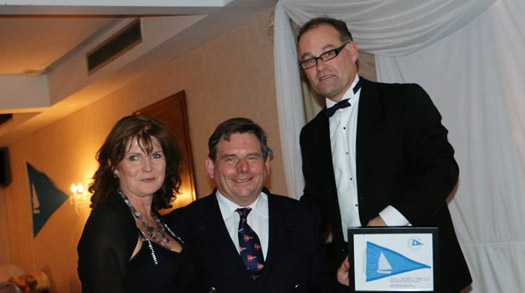
Commodore's wife Jane Johnston, Olympic Silver Medallist David Wilkins, and SDC Commodore Andy Johnston at the 75th Anniversary Dinner
The Commodore made reference to the recent launch by the President of our sport's most important strategic plan in many years. Outside of the high performance Olympic sector, sailing at grass roots is struggling and dinghy sailing especially needs significant help and support. On behalf of the membership of Sutton Dinghy Club, Andy said they were very proud of his selection as ISA President, and in welcoming the new strategic plan, he assured him that the members of SDC could be counted on to provide input and support to the ISA if required.
The Commodore also welcomed 12 former Club Commodores (Roy Dickson, Padraig O'Cearbhaill, Charles Sargent, Joe Phelan, Terry Harvey, Ian Sargent, Muriel O'Tiarnaigh, Padraic Boyle, Noel Dempsey, Dick Dunne, Tony Clery and Aidan Henry), and the Club's other living Olympians Barry O'Neill and Dan O'Grady. A special cheer was given for the attendance of David Hogg, the Club's oldest living National Champion, winner of International 12 Championship in Crosshaven in 1949. Also in attendance were 17 of the Club's young and enthusiastic instructors.
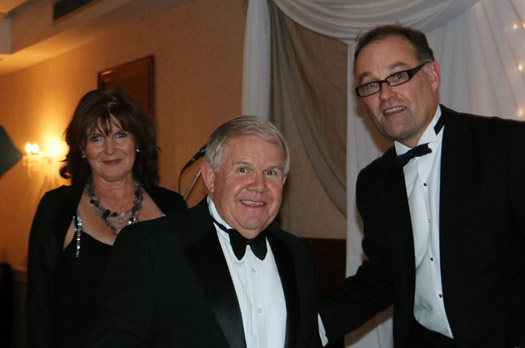
Jane Johnston, ISA President David Lovegrove, and Andy Johnston. David Lovegrove attended the 75th Anniversary Dinner both as President of the ISA, and as a former and very successful dinghy sailor at Sutton Creek.
In welcoming the guests to the Dinner, the Commodore spoke about the Club's welcome return to the upper end of competitive racing with good showing in both Mirror and GP14 National and International events this year, and of the opportunity the night presented to meet and welcome many former Champions and sailors from the Optimist, Mirror, GP14, Fireball and IDRA14 fleets down the years.
A brief jog down the Club's memory lane was undertaken by former National Champion and ISA Helmsman Champion Ruan O'Tiarnaigh, one of Sutton Dinghy Club's sailing greats. He mentioned how, from its early beginnings in 1940, Ireland's first ever and still running Team Racing event, the Book Trophy, was inaugurated in 1944 between Sutton Dinghy Club and what is now the Royal Cork YC.
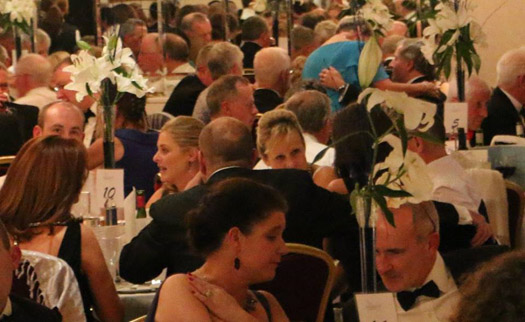
Sutton Dinghy Club is so highly regarded in its local community and on the national sailing scene that the 75th Anniversary Gala Dinner on Saturday night attracted an attendance of 204.
Another pioneering move was the creation in 1946 of the Irish Dinghy Racing Association (forerunner to the IYA and ISA) at a meeting held in the offices of Desmond Keatinge, the then Commodore of Sutton Dinghy Club. Ruan remarked that the Club, though very small membership-wise, has long played and continues to play a significant local community role in addition to punching well above its weight in the national sailing scene.
In listing the Club's achievements, Ruan referred to Sutton's five Olympians - Jem Sullivan, Alf Delany, Barry O'Neill, Jamie Wilkinson and Dan O'Grady - who attended Games in London, Helsinki, Montreal, Moscow and Atlanta. He also spoke of SDC's 35 Irish and overseas National Champions in 19 Classes – they have won more than 115 Championships between them. And he confirmed that the Club has provided 6 ISA Helmsmans Champions winning 8 Championships, with another 3 Junior Helmsmans Champions for good measure.
At various stages Sutton Dinghy Club have been at forefront of Fireballs (8 national championships and 6 runners-up), Mirrors (9 National Champions and 3 runners-up), Optimists (3 National Champions), GP14 (7 National Champions and 3 runners-up) and IDRA14 (30+ National Champions). Many of these former champions were in attendance on the evening.

Andy Johnston with former Olympian, dinghy champion and SDC member Barry O'Neill, and international sailing legend Roy Dickson, a former Commodore of Sutton DC who won his first international trophy under the SDC burgee in 1954.
Ruan's outline of the Club's story was completed with a reference to Sutton Dinghy Club's involvement in International events. Since 1954, when Roy Dickson and Brian Galton won an Inter-Country sailing event in YW Hornets held in Burnham-on-Crouch, UK, the Club's sailors have graced Admiral's Cup and Commodore's Cup teams, taken silverware back from Fireball, Mirror and GP14 Worlds and Kiel Week, and competed at the very top of professional sailing in the Sydney-Hobart Race and Australian 18ft skiffs.
A particular highlight was 1967, when eight Sutton Dinghy Club sailors attended the Fireball Worlds in Bendor in France, with Roy Dickson and Hugh Morton taking third, while David Lovegrove and Ian Baird were fourth. To the delight of the attendance, ISA President David Lovegrove was left speechless when he saw for the first time a snippet of video from this 1967 event including the prizegiving ceremony.
The formal aspect of the evening ended with presentation of mounted Club burgees by the Commodore and his wife Jane to all past SDC Commodores, the four Olympians (David Wilkins, Barry O'Neill, Jamie Wilkinson and Dan O'Grady), and to David Lovegrove. Then in the classic Sutton tradition, as recounted in loving detail in several pages of The Book, the evening ran on well into the early hours, with music and dancing and much reminiscing, a memorable way to celebrate 75 years, and a very special night for a very special sailing club.
More social photos from the night below
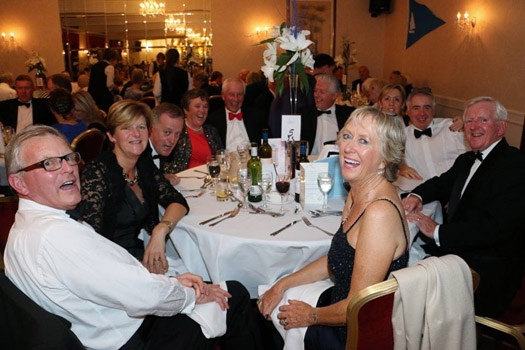



Despite light weather and a number of clashing events, the traditional end of season All Ireland youth sailing Inter-schools event at Sutton Dinghy Club attracted 91 boats across 11 classes, 21 schools and 119 sailors. Now in its 39th year, this event continues to be as enjoyed and as hard fought as ever across both Mixed and Optimist Fleets.
The 72 boat Mixed Fleet which saw 10 different classes produce close and tight racing under Portsmouth Yardstick. The PRO team of Jim Lambkin, supported by Liam Dineen (Skerries) and Scorie Walls did exceptionally well to get all 4 races in over the 2 days.
6th year student and team captain Thomas Natin (Laser Full), who has sailed in the event since his first year in Belvedere, went out in a blaze of glory taking the Individual Trophy, from St Fintans Robert Dickson & Lochlann O'Shea (Mirror), with Mount Temples Daniel Hopkins Laser 4.7) in 3rd.
Even with victory in the Individual series, Belvedere College had to be content with 4th place overall as St Fintans Sutton (Robert Dickson, Lochlann O'Shea, Darragh Kelly) took the Team Trophy (Conor Nolan Memorial) from a clearly delighted Sligo Grammar School (Fergus Collins, Harry Collins, Sam & Imogen Wray) with Blackrock College (Conor Byrne, James O'Connor, Patrick Riordan) taking 3rd. Sligo Grammar were 1 of 3 Sligo schools who made the trip to Sutton for the event.
Despite a clash with end of season Optimist event across the bay, the Interschools Optimist Fleet saw 19 boats take to the water with the PRO team of Paul Kavanagh and Padraic Boyle deciding to get 3 races in on Saturday on the off chance Sunday might be even lighter. The Individual Trophy went to Ella Hemeryck (Loretto Stephen Green) by a single point from Luke Rickard (Gonzaga) with Hugo Kennedy (St. Michaels) in 3rd.
The Team Trophy saw perennial contenders Belvedere College (Ben McDonald, Conor Waddilove, Sam Crawford) retain the title with Burrow School Sutton (Jonathan Sargent, Sophie Dix, Kirsten Quinn) 2nd with Loretto Balbriggan (Francis Mulholland, Ella May, Stephanie O'Connor) 3rd.
That 2nd place overall meant Burrow School Sutton took the Primary School Trophy.
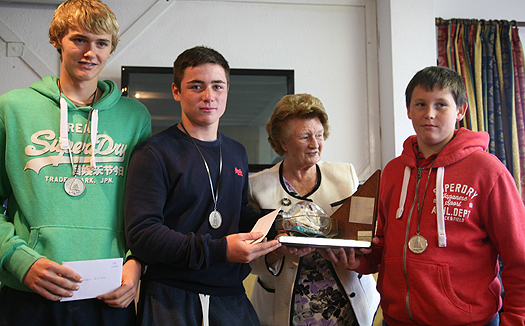
 ––
––
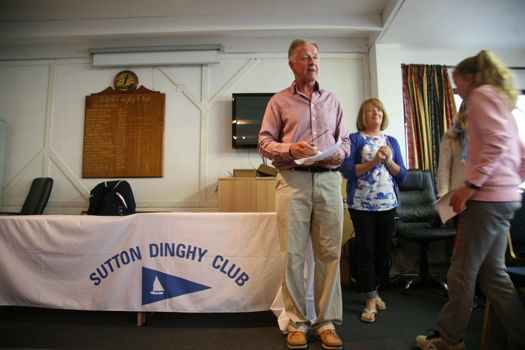
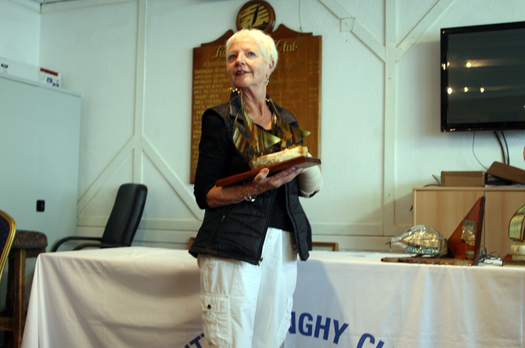
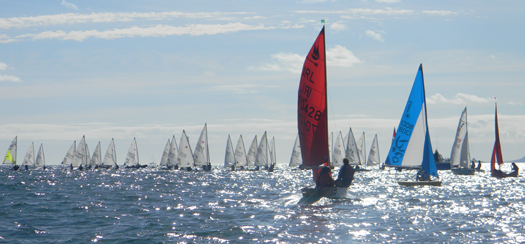
The O'Tiarnaigh Trophy for best Sutton Dinghy Club helm went to Darragh Kelly sailing for St Fintans Sutton who finished 4th overall sailing a Laser Radial.
This Trophy, presented by former Commodore Muriel O'Tiarnaigh, is in honor of her late husband, former Commodore and Belvedere teacher Riocaird O'Tiarnaigh who introduced the Inter-schools Sailing event back in April 1995. The 39th running of the event saw their grandson Fionn Mulhall take part in the Optimist fleet for the first time.
The 40th running of this event next year, should be a very special event.
Sutton Dinghy Club Hosts All Ireland Inter-Schools Sailing Event on Dublin Bay
#sdc1940 – Sutton Dinghy Club celebrates its 75th anniversary this year and in the month of September the Sutton Creek club is showing no signs of slowing down. This weekend a total of 95 boats are entered in the 39th All Ireland Inter-Schools Sailing Event. The regatta is being staged the same weekend as the All Ireland Junior Helmsmans Championships in Kinsale.
75 boats are entered in the Suttom Mixed Fleet (PY) championship and and an additional 20 Optimist dinghies in the dedicated Optimist fleet.
There will be almost 150 sailors from schools throughout the country competing against each other in Dart 16, Laser II, 420, Laser Full/Radial/4.7, Mirror, Feva, Topper and Topaz, as well as the Optimist fleet.
This most popular event has seen many schools compete for the coveted trophies over the past thirty-eight years. Each school nominates a Sailing Captain and may enter up to three teams, each team consisting of three (or two) boats, which for the Mixed Fleet may be of mixed class (except Optimists). The best two boat results over the event in each team will count. The members of each team MUST be nominated in advance.
Sutton Dinghy Club Juniors Travel To Royal Cork for 'Book' Competition
#royalcork – Today was a great day when the Sutton Book Junior Team arrived at the Royal Cork Yacht Club to compete for the Sutton Junior Book and received a warm welcome after their trip from Sutton Dinghy Club writes Claire Bateman.
The morning had started out misty but the fog cleared steadily to make way for a beautiful sunny day but with only about 3 knots of light breeze from the east. Having tossed a coin to select the boats both teams headed out to the Curlane Bank where they awaited breeze to start racing. The breeze failed to materialize so they moved further towards Spike where a course was laid. Race one commenced and the Royal Cork team were a little more sure of themselves being on home waters and following a penalty on one of the Sutton boats resulting in a penalty turn that race was won by the home team. Race two was a different kettle of fish. The Sutton team were growing stronger and there was a lot more panache about them and they went on to win that race.
Next on the race programme was the changing of the boats between the teams and with the sides level everybody was on tenterhooks.
And so it came all came down to the final race as all good events should do and despite the best efforts of Race Officer, Stephen O'Shaughnessy, several attempts to start resulted in general recalls. Finally, with the wind filling from the south west, two of the Royal Cork boats got away cleanly and led first and second with the third boat left to fend off the Sutton team and doing a pretty good job at this with the result Royal Cork were able to take the event.
The event today was a follow on to the sailing of the Senior Sutton Book in Sutton in August. Speaking after racing Rear Admiral Dinghies, RCYC, Celine McGrath, expressed her thanks to Sutton Dinghy Club for reviving this wonderful tradition in this the club's 75th anniversary year and to Andy Johnson, Sutton Commodore, whose perseverance led to the Senior leg taking place in August which was won by Sutton, and the Junior leg today that the Royal Cork won. She also expressed her thanks to Stephen O'Shaughnessy, Race Officer, Jim McGinley for mark laying, Tom Crosbie, Umpire, and to Wendy and Martin for helping and ferrying the Sutton team to Cork.




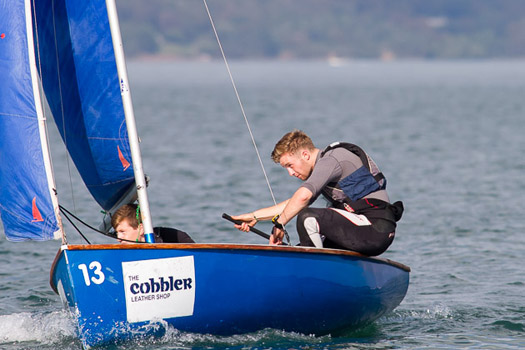
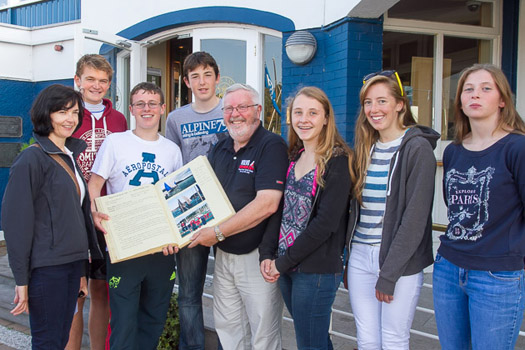
Winners –L to R Rear Admiral Dinghies Celine Mc Grath,Grattan Roberts, Jamie Tingle, Thomas Mc Grath, Admiral Pat Lyons, Suzi Fitzpatrick, Jill Mc Ginley, Rebecca O'Shaughnessy
Boating Visitors To Ireland's South Coast Get Mixed Welcome Messages
#marinetourism – Ireland's south coast provides an almost infinite variety of harbours, natural havens, and extensive areas of interesting sailing water. These cater for boat enthusiasts of all kinds, with craft of every type. So how does the welcome for visitors shape up? W M Nixon contrasts the different hospitality styles of four attractive ports.
The word on the grapevine that the Ballydehob Old Boat festival had taken place arrived with an intriguing photo from Anthony O'Leary. It had been noted in the interview with him immediately after he had led the team in Ireland's Commodore Cup Victory, that while he was trying to unwind for a while, it's not really in the O'Leary makeup to relax, and soon his mind was busy with new ideas of nautical interest.
Nevertheless he was cruising gently in early August down towards West Cork in the family's handsome big Nelson powercruiser Irish Mist, a fast and able vessel which his father Archie and mates like Mick Ahern once took right round Ireland in a settled springtime spell of weather, just to be in Dublin to watch Cork Con play rugby in some major championship at Lansdowne Road.
As it turned out, this year Irish Mist was getting down west ultimately to be in Baltimore for the 1720 Nationals in late August, which O'Leary duly won. But from time to time, he flashed back some photos of interesting boats met along the way, and one which really rang the bell was a little Ette Class clinker-built gunter-rigged sloop sailing in Castlehaven.
The Ette class originated way way back, when two keen dinghy cruising types sailed their little dinghy into Castlehaven, and the Castletownshend locals in the South Cork Sailing Club were so taken by the boat that they commissioned the waterfront boatbuilders, the O'Mahony brothers, to build some sister ships as the basis of a class.
All the new boats' names ended in "ette". And the class survived for many years, though at times the Ettes were hanging on by a thread. But recently it has had a fresh lease of life with new examples of what is now a classic dinghy being built by Lui Ferreira of Ballydehob, who last came through this parish when, in 2012, he put the first teak deck on a vintage Howth 17, the syndicate-owned Deilginis.
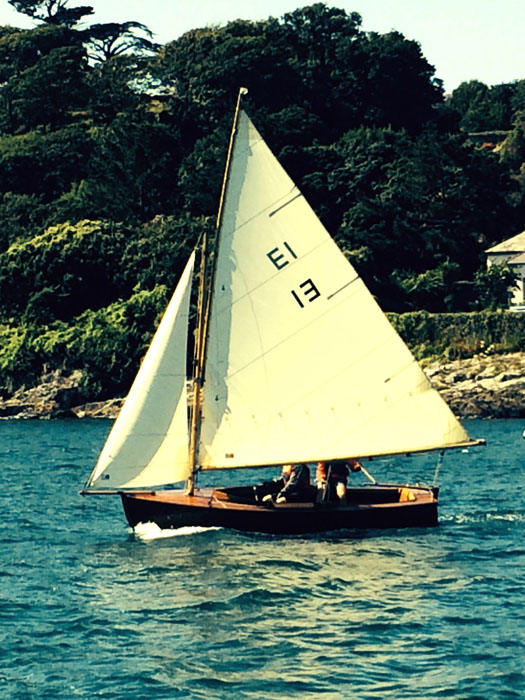
Perfection of summer – an Ette class in her home waters of Castlehaven. Photo: Anthony O'Leary
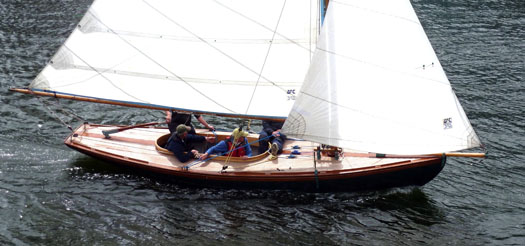 Rui Ferreira, builder in Ballydehob of the Ette Class, also put this teak deck on the 107-year-old Howth 17 Deilginis in 2012. Photo: W M Nixon
Rui Ferreira, builder in Ballydehob of the Ette Class, also put this teak deck on the 107-year-old Howth 17 Deilginis in 2012. Photo: W M Nixon
A Howth 17 looks well no matter how you photo her. But an Ette is a quirky little thing which can sometimes look odd from the wrong angle. Yet in a flash of inspiration, the Captain of the Commodore's Cup team took up his iPhone as an Ette came bustling down Castlehaven on fine sunny morning, and we got what I reckon to be one of the best photos of an Ette under way ever obtained – plus it gets the very essence of summer in Castlehaven.
The next O'Leary snap some days later was just briefly titled: "The Ballydehob Old Boat Festival, Irish Mist in archway second left". What was going on here? We'd heard vague stories about a very relaxed assembling of boat at high water at the drying quay at Ballydehob, but the O'Leary photo hinted at serious numbers and a high level of organization.

The teaser photo – first intimations of this year's Ballydehob Gathering of the Boats, with the O'Leary family's motor-cruiser Irish Mist (framed in the second arch from left) joining an eclectic group of 74 boats for a couple of hours at top of the tide. Photo; Anthony O'Leary
 This is most people's image of Ballydehob, crowded and very rural, with Mount Gabriel beyond. Only the more observant will notice the tidal river in the foreground. Photo: W M Nixon
This is most people's image of Ballydehob, crowded and very rural, with Mount Gabriel beyond. Only the more observant will notice the tidal river in the foreground. Photo: W M Nixon
To begin with, most casual visitors would scarcely think of Ballydehob as a seaport at all. Rather, it's the very essence of rural West Cork, a crowded little village where "laid-back" is the default mode, and it has been so for some time. It reached something of an apotheosis when Annie Barry (she's one of the Fergusons of Gubbeen Cheese) was running her wonderful Annie's restaurant on one side of the winding main street, and the Levis sisters Julia and Nell, feisty little ladies of mature years, were running Levis's pub across the way.
Julia and Nan were splendid folk of considerable standing, and it's said the pair of them were once squired to the West Cork Hunt Ball in Skibbereen by Jeremy Irons of Kilcoe Castle a few miles along the coast. As for the setup in Ballydehob, space was so limited in the restaurant that, having checked out your booking, you simply took up station in leisurely style across the street in the pub with Annie's menus and an aperitif or two, then Annie would come across the road and discuss your order, and a delightful evening would continue late into the night.
Alas, for some year now Annie's has been closed, though everyone lives in hope of somebody re-opening it. And in the pub, the old ladies have passed on. But now it's run by a great-nephew, and very successfully too. We got ourselves in there late on a velvet July evening this year to find the place was heaving with youth and beauty and high fashion in casual style - achingly trendy it has become.
It could have been a traditional local in any of the world's fashionable holiday areas except for one thing. A ball of fur, a terrier of some kind, emerged from among people's legs and barked its head off at me. I assumed it was because I carried a whiff of our own little Jack Russell. But the blushing girl owner told me with a big smile that her little dog must have thought I was a priest. Only along Ireland's south coast, near some former or still surviving Protestant enclave, would you have heard that particular excuse.
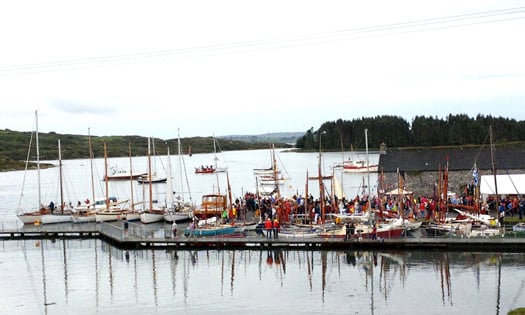 The old dock at Ballydehob is well able to receive a very varied fleet, seen here from the old railway viaduct Photo: Miriam Jones
The old dock at Ballydehob is well able to receive a very varied fleet, seen here from the old railway viaduct Photo: Miriam Jones
Just along the river from these scenes of hospitality and minor mayhem, immediately below the mighty railway viaduct which seems to be so disproportionate for the long-gone needs of the little West Cork Railway, there's Ballydehob Harbour. Time was when it was key to the place's economy, and it was in the late 1930s, only a year or so before World War II, that the Brooklands, the last surviving sail-only coasting schooner to deliver cargoes to West Cork, made her way up the winding estuary at the head of Roaringwater Bay (it's named for the Roaringwater River, much of the bay behind Carbery's Hundred Isles is well sheltered), to anchor just off the quay, as she was too deep to berth alongside.
The Brooklands was owned and skippered by Tom Creenan of Ballinacurra in the inner northeast reaches of Cork Harbour, but it was from Birkenhead or Goole on the Mersey that she'd bring her welcome cargoes of coal, a challenging passage at the best of times. At Ballydehob, while smaller cargo-carriers could get alongside the old quay, the Brooklands discharged her cargo into the multi-functional barge-type vessel known the Sandboat.
She was used by her owners, the Levis family, for just about everything, but primarily for going out among the islands towards high water, running up on a clean beach, then laboriously shovelling sand into the hold until the tide returned and the Sandboat could be floated off and piloted back to the quay where her eventually very useful cargo would be shovelled ashore to become builders' supplies.
The Sandboat was Queen of the Fleet at Ballydehob, and she played such a central role in the Levis family's life that Old Boat Festival organiser Cormac Levis's brother calls his pub in Ballydehob the Sandboat.
As for how Cormac himelf first got the notion for the Ballydehob Gathering of the Boats, he has been a tower of strength in the Traditional Boat movement, particularly in West Cork but also throughout Ireland, for many years. And with others following his example in restoring or even building new sailing lobster boats to traditional design, he suggested that getting together at Ballydehob during the little town's time-honoured summer festival around August 15th might hit the spot. And for the first one in 2004 –making this year's the tenth anniversary - they assembled nine boats, which was considered pretty good going.
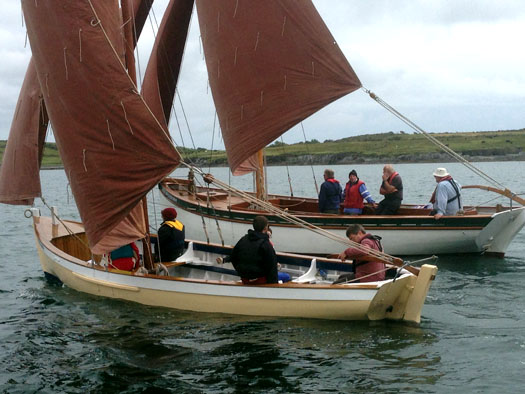
Close-up on Cormac Levis's lobster boat, which led the way for the first gathering of traditional craft at Ballydehob in 2004. Photo: Brian Marten
From it, they learnt that, for the future, while the aspiration would of course be for quiet and easy-going organization under a light hand, underneath it all there'd have to be efficiency, always with an eye on the clock. Although the tidal window is more than two hours for most boats, they've successfully accommodated modern yachts up to two metres draft without anyone being left behind stuck on the mud. But with limited manoeuvring space in both the harbour area and the channel, once the witching hour of high water is upon the fleet, it's time to start thinking about an orderly departure after two solid hours and more of good crack, mighty barbecues, and much interest in an examination of other people's traditional and classic boats.

Even among the sister-ships of the lobster fleet, many individual variants in hull lines and rig are apparent. Photo: Brian Marten

Just to add to the variety and colour, the Ilen Trust from Limerick brought their much-travelled Shannon Gandelows (right) to Ballydehob. Their stylish pennants are a legacy of heir successful visit to Venice at the end of April this year. Photo: Gary MacMahon
So the crucial thing is to select the ideal Saturday nearest to August 15th with a good big tide in mid-afternoon. As the Boat Gathering is such a force in its own right, they can range quite extensively on either side of August 15th, and to date the earliest has been August 8th, while the latest was August 21st.
This year's was Saturday August 9th, and while there may have been rain later in the day despite West Cork having much more sunshine in August than almost any other part of the country, no-body now remembers the rain as they recall the sheer fun and sense of community of what has been described by Tiernan Roe, another of the quality boat-builders of Ballydehob, as the "shortest bestest Boat Festival in the World".

Yet another creation of the active Ballydehob boat-building scene. This is an attractive little Cape Henry 21 cutter lunched in June by Tiernan Roe of Roe Boats. Photo: Tiernan Roe
For this year, it attracted 75 boats, though admittedly last year's record entry of 50 boats was greatly enhanced by this year's decision by the Drascome Lugger Association to combine Ballydehob in their 2014 cruise-in-company in West Cork, thereby adding 27 boats at a stroke.
But even with 27 boats of one class, the variety across the fleet as a whole was remarkable. So how do they assemble such a disparate fleet of boats with obviously highly-individual skippers, in such a quietly efficient way? For you'll never see or hear the Ballydehob Gathering of the Boats being publicly advertised all that much beforehand.
The method is perfectly simple. Everyone with an interest will know it is likely to be coming up on the agenda. So a month and more beforehand, Cormac will text them with the final date on a need-to-know basis. It works, and it sets the tone of quiet consideration for others and their boats in a very special festival in which some quiet sponsorship by CH Marine and West Cork-based German traditional boat fan Thomas Drewes sees that all participants get mementoes including cherished T-shirts (definitely not for general release), while barbecue facilities keep the good humour buzzing until everyone departs in style for their anchorage for the night, for although most boats hope to be berthed in Ballydehob on the big day more two hours hours before high water, once the ebb has started the channel has become much less forgiving about any pilotage errors.
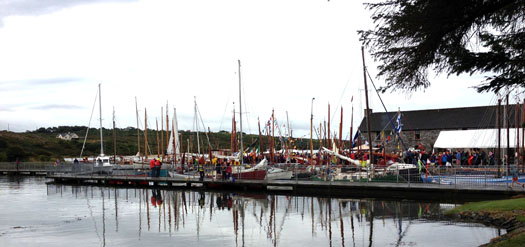
They're all here, as neatly berthed as you could please, but getting them away as the ebb starts requires good seamanship and boat-handling skills. Photo: Miriam Jones
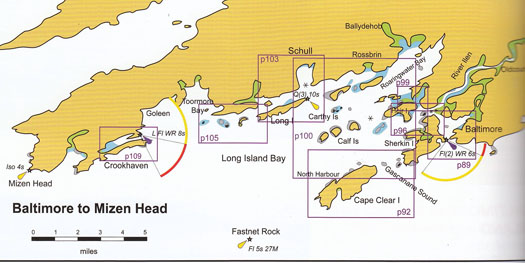
Ballydehob's central position in a hugely varied and welcoming crusing coast is emphasized by the number of other harbour chartlets indicated in this plan of the prime cruising area of West Cork. Plan Courtesy Irish Cruising Club
It's good to see a locally-focussed event like this now coming of age with a very healthy turnout. Eastward along the south coast, last weekend saw another event which will surely grow in stature and numbers, the second staging of Y2V Cruise-in-Company on the River Blackwater up the estuary from East Cork to West Waterford, as a flotilla of ten boats - eight GP14s, a Mermaid and a Feva – sailed up-river from Youghal to Villierstown.
It has been promoted by Youghal schoolboy GP 14 skipper Adrian Lee, and last year the inaugural tiny flotilla managed most of the sailable river by going to the bridge at Cappoquin before returning downriver to Villierstown. This year it achieved deserved support from the GP 14 class, with the furthest road-trailed from sea level being incoming Irish GP 14 Association President Stephen Boyle from Sutton DC, while the furthest-travelled in terms of elevation above sea level were the Blessington group, who came down from the Wicklow Hills with their Geeps and included Richard Street and kids (see again this blog on 26th July), and a brand new Duffin boat belonging to Simon Culley and Libby Tierney.
As for seniority, the classic of the class was a 60-year-old beautifully-restored Bell Woodworking GP 14 owned and skippered by 16-year-old Jack Nolan, another of that group of Youghal youngsters who are taking local dinghy sailing forward with gusto, while further variety was provided by Norman Lee of Greystones, his crew including the inevitable family pooches which are such a part of the GP 14 scene.
The sailing was mixed – as Norman said, in a river the wind will always be ahead some time, and though we think of the secret Blackwater Estuary as being fairly straight, in fact there are some quite significant curves. It took about four-and-a-half hours to sail up, and a brisker four hours to return on Sunday morning's ebb.
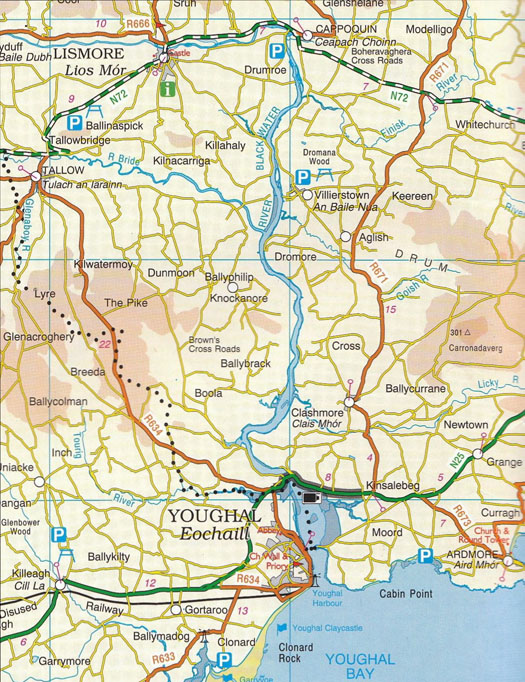
The secret waterway – the Blackwater Estuary from Youghal up to Cappoquin and almost to Lismore is one of Ireland's least-sailed rivers

Villierstown's new clubhouse, open only three weeks, was ready and willing to make welcome the crews who had sailed up from Youghal. Photo: Norman Lee

The new facility, Villierstown's "floating pier"
(right), was originally the in-harbour pontoon at Dungarvan SC. Photo: Norman Lee
At Villierstown, the new clubhouse of the Villierstown Boating & Activites Cub had been open only three short weeks, but they've made good use of a sports council grant, and it well fulfills a multi-purpose role, including providing the hospitality needed by sailing campers, with Paul Virtue and his wife Caroline organising a fine feast in the clubhouse on the Saturday night, and an enormous breakfast on Sunday to send them on their way downriver to round out an event which has future annual success written all over it.
One of the reasons it all went so well was that the slightly cogglesome little plastic floating jetty, along which the sailors of Villierstown used to access their small boats, has been replaced by a proper pontoon which the club acquired when Dungarvan SC eastward along the coast up-graded their in-harbour pontoon. In fact, Dungarvan support for the development of Blackwater sailing didn't stop there, as one of the fleet in the Y2V was a vintage Dungarvan-based Mermaid in which owner Eugene Burke has cruised the entire south coast between Ballycotton and Kilmore Quay.
The boat is Akita, Mermaid No. 85, and she has certainly been around, as she was built in the Barkyard in Skerries in 1953 by Joe and Matt Boylan. The Barkyard was originally the place where the Skerries-based coasting schooners and fishing boats had their sails preserved against rot by tanning with bark, but in the 1950s the now redundant premises were used to build some of the eventually enormous fleet of Skerries Mermaids through a boat-building class run by the colourful Jem Kearney.
The Fingal region around Skerries and Rush continues to be the great heartland of the Mermaids, with some very racy boats built in the old mill at Rogerstown recently, but despite the modern challenge, this year's Mermaid Week at Rush saw the champion emerge in the form of Jonathan O'Rourke of the National YC with his vintage boat, one of the few Mermaid sailors still in Dun Laoghaire.

The welcoming port. Despite its tidal limitations, Dungarvan lays on the welcome in a big way. This shows a visiting fleet at the original pontoon, which has now been moved to Villierstown. Photo Kevin Dwyer, courtesy Irish Cruising Club
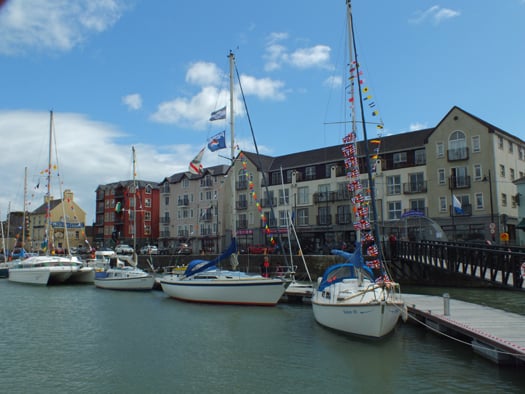
Dungarvan SC's new in-harbour pontoon has much improved the alongside berthing space, but unfortunately the local Council wouldn't permit dredging to improve access.......Photo: Donal Walsh

....and thus the reality for most boats in the Inner Harbour is a drying berth.......... Photo: W M Nixon
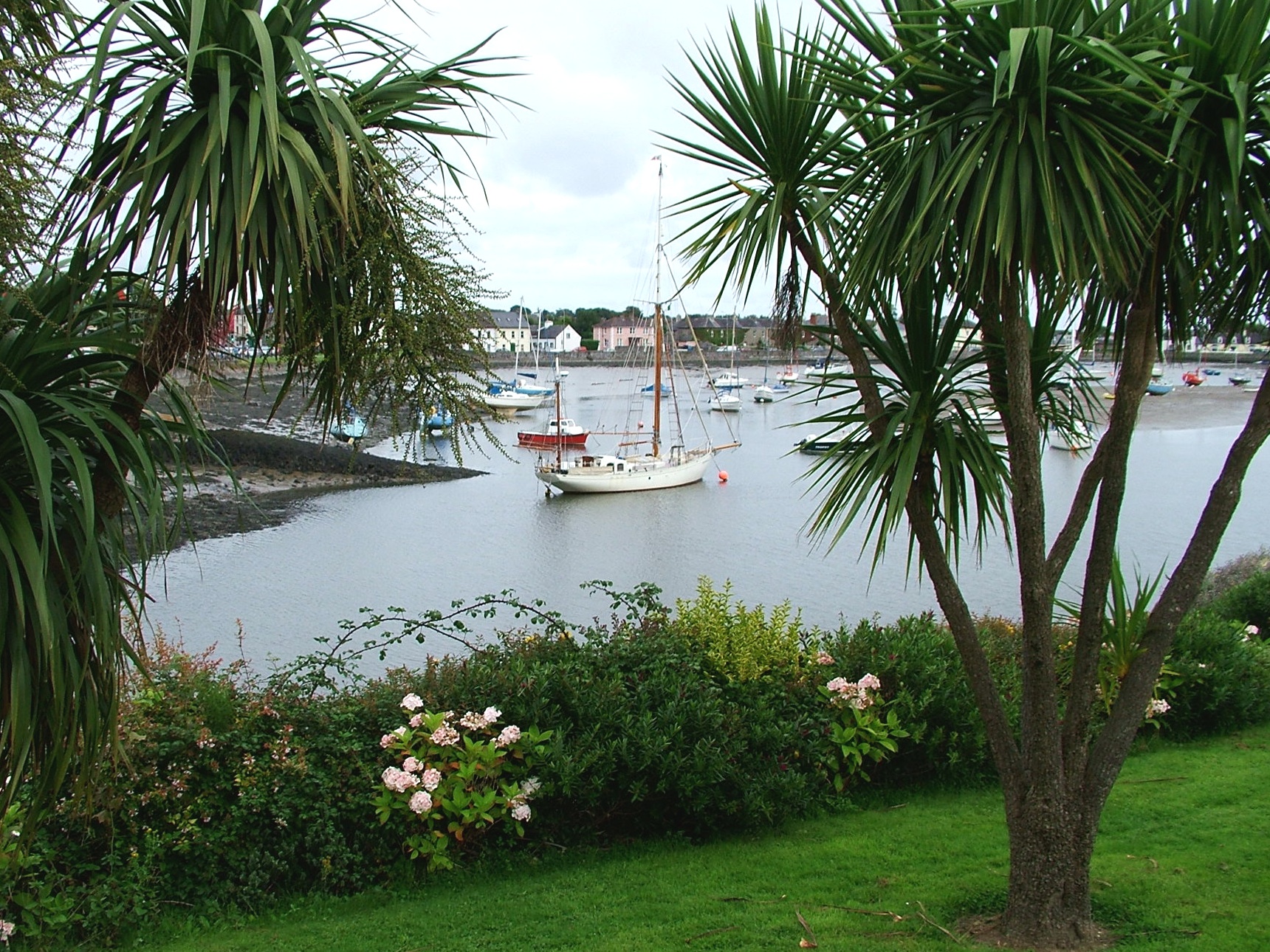
....but if you've access to local knowledge, there is a deep pool just below the bridge........Photo: Donal Walsh
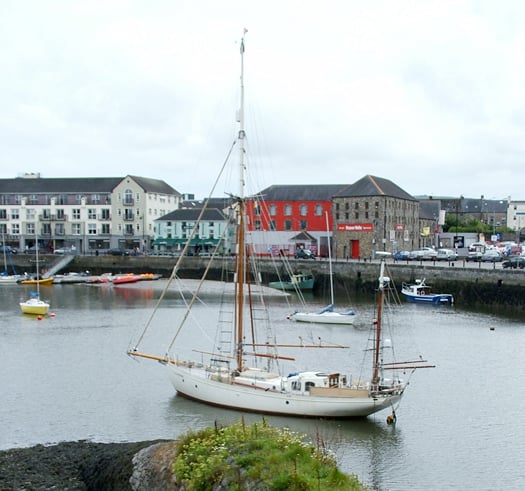
.....and here the Northwest Passage transiting 44ft steel gaff yawl Young Larry is visiting in comfort and style. Photo: Donal Walsh
Meanwhile in Dungarvan the club's hopes of doing a bit of dredging to improve access to their extended in-harbour pontoon was stymied when the council said they wouldn't permit any salt-contaminated sludge being brought up onto the quay. But despite its tidl limitations, it's a hugely hospitable place, and if you do take the ground at the pontoon, it's mostly soft and forgiving mud which enables you to sit in relative comfort. Certainly some very substantial cruising boat have overnighted here to enjoy the fine pubs both on the waterfront waterfront and in the town, while culinary standards are set by Paul Flynn's famous restaurant The Tannery just round the corner.
Nevertheless if you absolutely won't let your boat dry out, leading Dungarvan cruising man Donal Walsh (he has just returned from an epic round Ireland and Britain clockwise cruise with his Moody 31 Lady Kate) well knows the deep pool across the harbour close under the bridge, and he saw to it that his brother-in-law Andrew Wilkes and sister Maire Breathnaith found a secure berth there for their hefty 44ft steel-built gaff yawl Young Larry, a boat in which they transited the Northwest Passage, but she looks well at home in Dungarvan with its fine tradition of first class locally-based trading schooners.
In moving along the south coast, we find that when possible, they'll lay out the welcome mat big-time in Ballydehob, Youghal, Villierstown and Dungarvan, despite the fact that all four places are restricted in what they can do by the exigencies of tide.
So how are things working out in Dunmore East, the one port which has the potential to be one of the most welcoming and accessible all-tide sailing and fishing ports along the entire south coast?
Despite this potential, the under-development of its facilities, fuelled by a sometimes poisonous attitude between fishermen and other harbour users, has provided recreational visitors with often unpleasant memories. In trying to understand why this might be so, we have to understand how Dunmore East came to get its pretty little harbour. When it was built in the first half of the 19th Century, it was not – as is commonly supposed – built for the benefit of fishermen. The horrible fact is that fishermen came so far down the pecking order that they just had to make do for themselves as best they could.
The handsome new pier at Dunmore East, designed by Alexander Nimmo who is best known for developing Tobermory in Scotland and many places in Galway including Roundstone, was constructed exclusively for the use of the new fast sailing cross-channel packet boats serving the top people of Waterford in their trading and communication with Britain, while the unfortunate local fishermen were forced to keep their boats in the limited shelter of The Cove to the north of it, and haul them on the exposed beaches at The Strand and Councillors Strand.
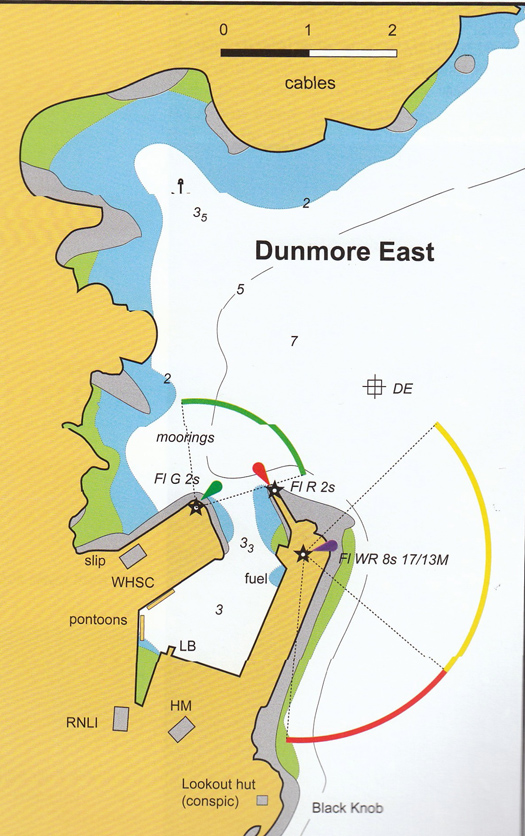
Dunmore East's substantial pier was new-built originally to provide a port for cross-channel sailing Packet Boats, serving Waterford ten miles up the road. When this was its primary function, any local fishermen were banished to the poorly-sheltered coves to the north, with their boats being hauled up on the exposed beaches beyond. Plan courtesy Irish Cruising Club
Soon, however, steam driven packet boats were able to go conveniently all the way up to Waterford, and Dunmore East was redundant as a packet-boat harbour. But it was only with reluctance that fishing boat were allowed to start using it, as the Royal Navy would have been keeping an eye on its possibilities for their own occasional use.
Yet down the years, the idea has developed that Dunmore East was always primarily a fishing harbour, and to a lesser extent the same attitude prevailed at Howth on the east coast, where the new harbour functioned as the Packet Boat station for Dublin only between 1817 and 1826, when the developing new asylum harbour at Dun Laoghaire became the selected port for the Royal Mail's new paddle steamers serving the cross-channel route. Yet the silted harbour at Howth was only allowed to become a "fishing station" in the 1850s.
The legacy of all this, in Dunmore East at any rate, is that there still seems to be a suspicion among the fishing community that their tenure is only temporary, that the powers-that-be would move them out if they see a better use for the place. How else can we explain the negative and almost paranoid attitude of the fishing spokesmen every time a suggestion for a much-needed marina at Dunmore East is put forward?
With all this in mind, I made a quick visit to Dunmore East in mid-August while on other business in the southeast, in the hope of seeing if a much-trumpeted €4 million dredging scheme was now in progress in the harbour, and also to see how an equally celebrated new Visitors Pontoon along the East Pier was working out.
The photos speak for themselves. There wasn't any sign of a dredger, though doubtless that will turn up in due course. Yet as for the 40 metre pontoon, it's not a leisure-boat-friendly neat little piece of work at all, but is quite a massive and brutal steel box structure more suited to rugged fishing boats, who were showing their approval by using it so totally that the only leisure visitor was a German motor-cruiser which had managed to squeeze in at one end.
But as this pontoon is on the wrong side of the harbour for ease of access to the Sailing Club on the west side, and the welcoming facilities in the village above it, any pedestrian boat visitor – the vast majority of incoming leisure boaters, in other words – has a long trek through the sometimes crowded and malodourous delights of a fishing port before they can access any amenities. So not surprisingly the German boat had its inflatable tender moored outside it for quick and easy movement across the harbour, and along to the beaches if wished, a situation which inevitably precluded any other newly-arrived boat from rafting up alongside
So for any cruising boat coming in from sea, often with the challenge of Hook Head just recently put astern, it wasn't a welcoming setup. In fact, it was downright hostile. While we were there, an ordinary sailing cruiser with happy folk aboard came motoring from the eastward to round the end of the pier after stowing their sails, but their hopes of a convenient and enjoyable visit to Dunmore East were soon dashed. No welcoming RIB came out from the sailing club to direct them to a vacant mooring, as there probably wasn't one. And as for the pontoon, "unwelcoming" is inadequate. It clearly didn't want anything to do with them. You could see their spirits wilting as they headed out, faced with the long haul up to the marina in Waterford City. The current visitor berthing situation in Dunmore East is at the very least a sad business, so where does it go from here?

Dunmore East in mid-August. No sign of any dredging, and the "Visitors Pontoon" under the lighthouse on the East Pier is packed out with fishing boats.......Photo: W M Nixon
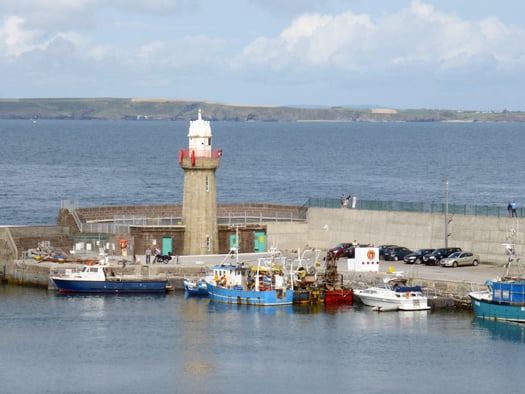
........and just one visiting German motor cruiser which was protected against any rafting up by its tender on the outer side. Photo: W M Nixon

The new pontoon is an industrial standard piece of kit......Photo: W M Nixon
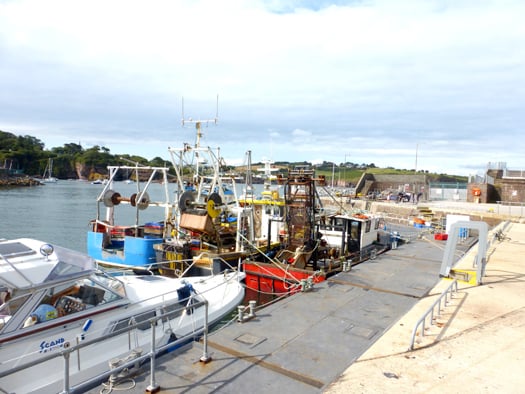
....and understandably very popular with active fishing boats. Photo: W M Nixon

But for visiting sailing boats newly arrived in port.......Photo: W M Nixon
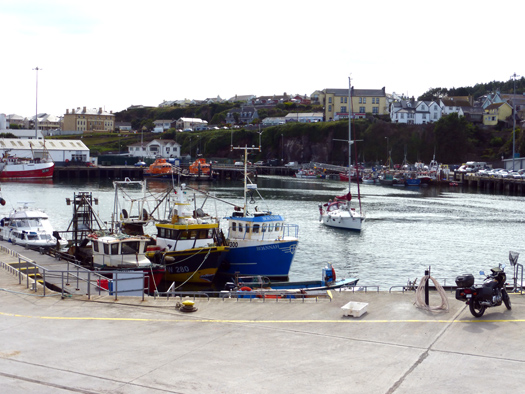
....it's soon clear that there isn't really a welcoming berth for them.....Photo: W M Nixon
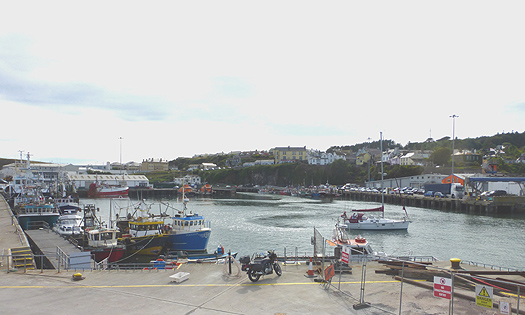
....and they head out to sea again, visibly disappointed by their Dunmore East welcome. Photo: W M Nixon
Sutton Dinghy Club Pair Win Mirror National Championships
#mirror – The 2014 Mirror National Championships were held at a resplendent Sligo Yacht Club from August 7th to 10th. Twenty three Mirror Class Dinghies gathered for what proved to be an action packed four days of sailing on the enchanting waters of Sligo Bay.
The fleet faced very tricky sailing conditions over the four days in relatively light and shifty winds, not the norm for Sligo Bay. Conditions notwithstanding, the event was a major success with not a single general recall throughout the four days. A big thank you to all the competitors and families that made the trip to Sligo.
Shane Mcloughlin and his crew Oscar Langan from Sutton Dinghy Club mastered the conditions best, demonstrating some excellent sailing skills to take overall honours. Fast improving locals, Samuel and Imogen Wray took the honours in the silver fleet while Muiris Fitzgerald and Ellen O' Dwyer, also local, topped the bronze fleet.
Ten races were held over the four days. Forty six eager sailors set out on Thursday to do battle in hellishly tricky winds. One could not but have sympathy for OD Brendan Brogan as winds varied over 90 degrees, playing havoc with course laying. In the end, patience proved a virtue and Lough Ree's Tiernan Dickson took the first race with Shane Mc Loughlin and Jack Maye filling second and third spots. Lough Ree Yacht Club was again to the fore in the second race as the rapidly improving pair, Caolan Crossdell and Schull Harbour's very own Oisin MacAllister took line honours in a tight finish from Tiarnan Dickson and Alex Leech, in what was surely the performance of the weekend.
Day two was again frustrating for sailors as the shifting winds caused quite a few delays. Some sailors learned the hard way about the strong tides in Sligo Bay, while racing in the calm conditions. Shane McLoughlin from Sutton Dinghy Club turned the heat up, winning two races and finishing second in the last race to claim the overnight lead. Sligo's Beth Armstrong took the honours in the last race shooting right into contention behind Shane Mc Loughlin and the ever consistent Tiarnan Dickson. The two Jack's, Maye and Ryan kept their hopes up with a second place each.
Day three brought more shifty wind conditions to challenge the fleet. It was Tiarnan Dickson's turn to pile on the pressure with two wins and a third place finish. Ominously though, Shane Mcloughlin had two seconds and a win. The gap between the pair was just two points entering the final day. Beth Armstrong put in a very consistent shift and went into the last day right in contention should there be any slip ups.
Day four saw somewhat more consistent winds during which the final two races were sailed. Shane Mc Loughlin took the first from Beth Armstrong with Jack Maye in third. The final race turned into a local duel between cousins Beth Armstrong and Jack Maye, Jack taking an extended lead before Beth came through to take line honours and bring the shutters down on a thoroughly enjoyable 2014 National Championship.
And so it was, a splendid four days for the Mirror fleet soaked in the famous hospitality of Sligo Yacht Club. Those lucky enough to be present were reminded of the glory days of Irish sailing. Mingling with sailors, parents and club members, it was easy to understand how the Mirror Class has contributed so much to so many in Irish sailing down through the years.
Results:
Gold Fleet:-
1] Shane Mc Loughlin / Oscar Langan 12 points Sutton Dinghy Club [SDC]
2] Tiarnan Dickson / Alex Leech 18 points [LRYC]
3] Beth Armstrong / Dylan Shaw 20 points [SYC]
Silver Fleet:-
1] Samuel Wray / Imogen Wray [SYC]
2] Helen Smith / Noah Canham [SYC]
3] Rory Mc Allister / Lughaidh Croasdell [Schull Harbour & LRYC]
Bronze:-
I] Muiris Fitzgerald / Ellen O' Dwyer [SYC]
2] Sarah White / Matthew White [SYC]
3] Hannah Raftery / Ben Kelly [SYC]





























